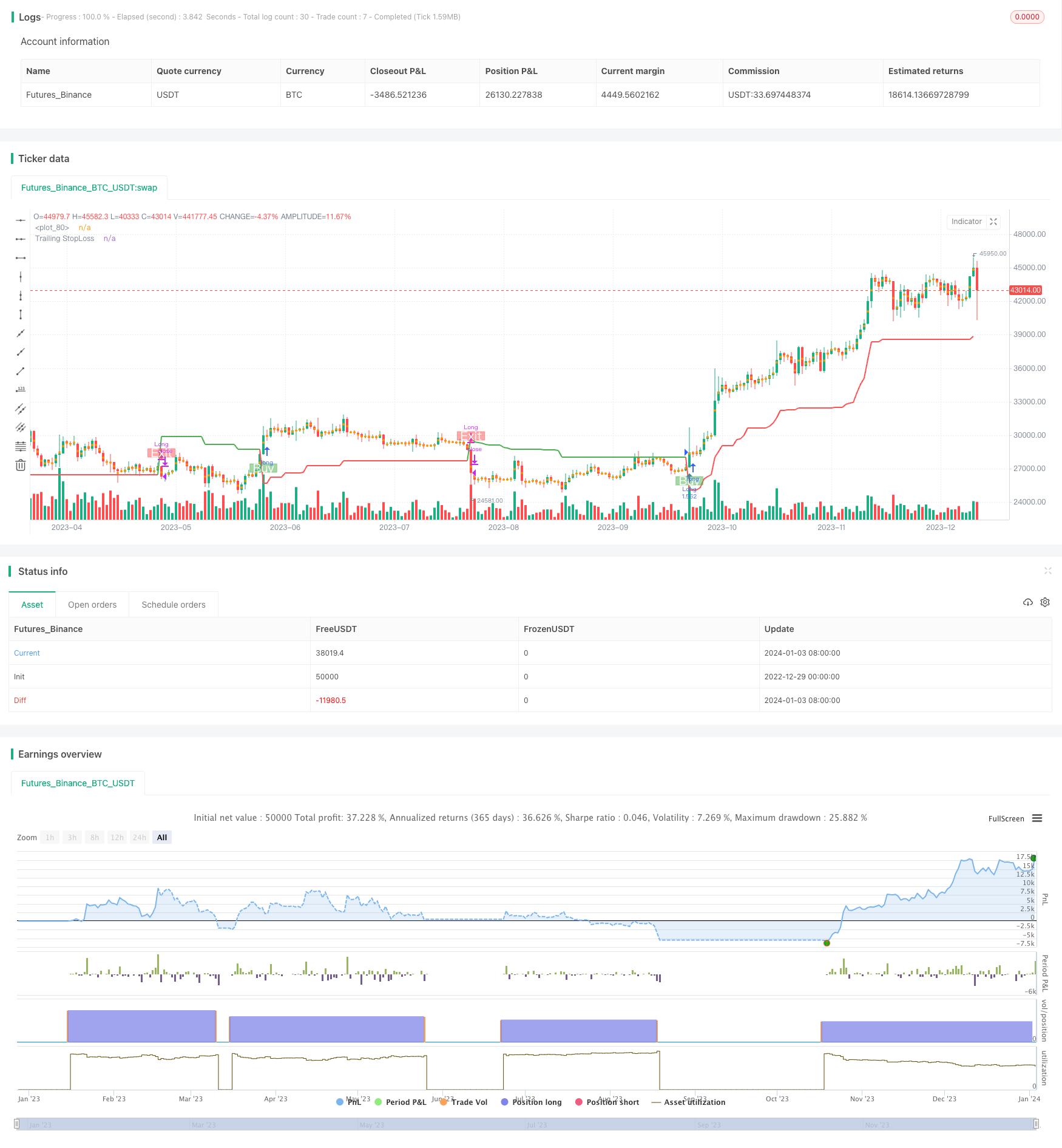
概述
该策略是一个基于平均真实波幅(ATR)的趋势跟踪策略。它使用ATR来计算指标值,从而判断价格趋势方向。该策略同时提供止损机制来控制风险。
策略原理
该策略使用三个主要参数:周期Period、乘数Multiplier和进出场点Entry/Exit Point。默认参数为14周期的ATR和4倍的乘数。
该策略首先计算多头均价(buyavg)和空头均价(sellavg),然后比较价格与这两个均价的关系,判断目前的趋势方向。如果价格高于空头均价,则判断为多头;如果价格低于多头均价,则判断为空头。
此外,该策略结合ATR来设定 추踪止损(Trailing Stop Loss)。具体方法是:以ATR的14周期加权移动平均乘以一个乘数(默认为4)作为止损距离。这样可以根据市场波动程度来调整止损距离。
当止损被触发时,该策略就会平仓了结利润。
策略优势
- 基于趋势判断,能够顺势而为,持续获利
- 采用ATR动态调整止损距离,可以有效控制风险
- 计算买卖点位简单直接,容易理解实现
风险及对策
- 趋势发生转变时,可能出现较大亏损
- 适当调整ATR周期和乘数,优化止损距离
- 震荡行情中, WILL产生多次小额损失
- 增加过滤条件,避免震荡市
- 参数设置不当可能导致策略效果变差
- 多组合参数优化测试,找到最佳参数
策略优化方向
1.加入其他指标判断过滤信号,避免在震荡行情中出入场 2.优化ATR周期和乘数参数,使止损距离更加合理 3.加入开仓仓位控制,根据市场情况调整仓位大小
总结
该策略整体来说是一个简单实用的趋势跟踪策略。它只需要少量参数即可实现,通过ATR来动态调整止损,可以有效控制风险。如果搭配其他辅助判断指标,可以进一步优化,过滤掉一些噪音信号。总的来说,该策略适合那些想要学习趋势跟踪策略的人,也可以作为其他高级策略的基础组件来使用。
策略源码
/*backtest
start: 2022-12-29 00:00:00
end: 2024-01-04 00:00:00
period: 1d
basePeriod: 1h
exchanges: [{"eid":"Futures_Binance","currency":"BTC_USDT"}]
*/
//@version=5
strategy('Trend Strategy by zdmre', shorttitle='Trend Strategy', overlay=true, pyramiding=0, currency=currency.USD, default_qty_type=strategy.percent_of_equity, initial_capital=10000, default_qty_value=100, commission_type=strategy.commission.percent, commission_value=0.005)
show_STOPLOSSprice = input(true, title='Show TrailingSTOP Prices')
src = input(close, title='Source')
out2 = ta.ema(src, 20)
buyavg = (close + high) / 2.02 - high * (1 - open / close) * (1 - low * open / (high * close))
sellavg = ((low + close) / 1.99 + low * (1 - low / open) * (1 - low * open / (close * high)) / 1.1 + out2 )/ 2
// === INPUT BACKTEST RANGE ===
fromMonth = input.int(defval=1, title='From Month', minval=1, maxval=12)
fromDay = input.int(defval=1, title='From Day', minval=1, maxval=31)
fromYear = input.int(defval=2021, title='From Year', minval=1970)
thruMonth = input.int(defval=1, title='Thru Month', minval=1, maxval=12)
thruDay = input.int(defval=1, title='Thru Day', minval=1, maxval=31)
thruYear = input.int(defval=2100, title='Thru Year', minval=1970)
// === INPUT SHOW PLOT ===
showDate = input(defval=true, title='Show Date Range')
// === FUNCTION EXAMPLE ===
start = timestamp(fromYear, fromMonth, fromDay, 00, 00) // backtest start window
finish = timestamp(thruYear, thruMonth, thruDay, 23, 59) // backtest finish window
window() => true
// === TRAILING STOP LOSS === //
ATR_Period = input(14)
ATR_Mult = input(4.0)
var float ATR_TrailSL = na
var int pos = na
atr = ta.rma (ta.tr(true), 14)
xATR = ta.atr(ATR_Period)
nLoss = ATR_Mult * xATR
iff_1 = close > nz(ATR_TrailSL[1], 0) ? close - nLoss : close + nLoss
iff_2 = close < nz(ATR_TrailSL[1], 0) and close[1] < nz(ATR_TrailSL[1], 0) ? math.min(nz(ATR_TrailSL[1]), close + nLoss) : iff_1
ATR_TrailSL := close > nz(ATR_TrailSL[1], 0) and close[1] > nz(ATR_TrailSL[1], 0) ? math.max(nz(ATR_TrailSL[1]), close - nLoss) : iff_2
iff_3 = close[1] > nz(ATR_TrailSL[1], 0) and close < nz(ATR_TrailSL[1], 0) ? -1 : nz(pos[1], 0)
pos := close[1] < nz(ATR_TrailSL[1], 0) and close > nz(ATR_TrailSL[1], 0) ? 1 : iff_3
atr_color = pos == -1 ? color.green : pos == 1 ? color.red : color.aqua
atrtrend = plot(ATR_TrailSL, 'Trailing StopLoss', atr_color, linewidth=2)
// === Stop Loss === //
slGroup = 'Stop Loss'
useSL = input.bool(false, title='╔══════ Enable ══════╗', group=slGroup, tooltip='If you are using this strategy for Scalping or Futures market, we do not recommend using Stop Loss.')
SLbased = input.string(title='Based on', defval='Percent', options=['ATR', 'Percent'], group=slGroup, tooltip='ATR: Average True Range\nPercent: eg. 5%.')
multiATR = input.float(10.0, title='ATR Mult', group=slGroup, inline='atr')
lengthATR = input.int(14, title='Length', group=slGroup, inline='atr')
SLPercent = input.float(5, title='Percent', group=slGroup) * 0.01
Shortposenter = input.bool(false, title='ShortPosition')
longStop = 0.0
shortStop = 0.0
if SLbased == 'ATR'
longStop := ta.valuewhen(pos == 1, low, 0) - ta.valuewhen(pos == 1, ta.rma(ta.tr(true), lengthATR), 0) * multiATR
longStopPrev = nz(longStop[1], longStop)
longStop := close[1] > longStopPrev ? math.max(longStop, longStopPrev) : longStop
shortStop := ta.valuewhen(pos == -1, ta.rma(ta.tr(true), lengthATR), 0) * multiATR + ta.valuewhen(pos == -1, high, 0)
shortStopPrev = nz(shortStop[1], shortStop)
shortStop := close[1] > shortStopPrev ? math.max(shortStop, shortStopPrev) : shortStop
shortStop
if SLbased == 'Percent'
longStop := strategy.position_avg_price * (1 - SLPercent)
shortStop := strategy.position_avg_price * (1 + SLPercent)
shortStop
exitLong = pos == -1
// === PlotColor === //
buySignal = pos == 1 and pos[1] == -1
plotshape(buySignal, title="Long", location=location.belowbar, style=shape.labelup, size=size.normal, color=color.new(color.green,50), text='Buy', textcolor=color.white)
exitSignal = pos == -1 and pos[1] == 1
plotshape(exitSignal, title="Exit", location=location.abovebar, style=shape.labeldown, size=size.normal, color=color.new(color.red,50), text='Exit', textcolor=color.white)
hPlot = plot(ohlc4, title="", style=plot.style_circles, linewidth=0, editable = false)
longFill = (pos == 1 ? color.new(color.green,80) : na)
shortFill = (pos == -1 ? color.new(color.red,80) : na)
fill(hPlot, atrtrend,color=longFill)
fill(hPlot,atrtrend, color=shortFill)
// === Strategy === //
strategy.entry('Long', strategy.long,limit = buyavg, when=window() and pos == 1,comment="Entry: "+str.tostring(buyavg))
strategy.close('Long', when=window() and exitLong , comment='Exit: '+str.tostring(sellavg) )
if Shortposenter
strategy.entry('Short', strategy.short, when=window() and pos== -1,comment="Entry: "+str.tostring(close))
strategy.close('Short', when=window() and pos == 1 , comment='Exit: ')
if useSL
strategy.exit('Stop Loss', 'Long', stop=longStop)
// === Show StopLoss Price === //
if show_STOPLOSSprice
if pos == -1
label ShortStop = label.new(bar_index, na, 'SL: ' + str.tostring(ATR_TrailSL), color=color.green, textcolor=color.white, style=label.style_none, yloc=yloc.abovebar, size=size.small)
label.delete(ShortStop[1])
if pos == 1
label LongStop = label.new(bar_index, na, 'SL: ' + str.tostring(ATR_TrailSL), color=color.red, textcolor=color.white, style=label.style_none, yloc=yloc.belowbar, size=size.small)
label.delete(LongStop[1])